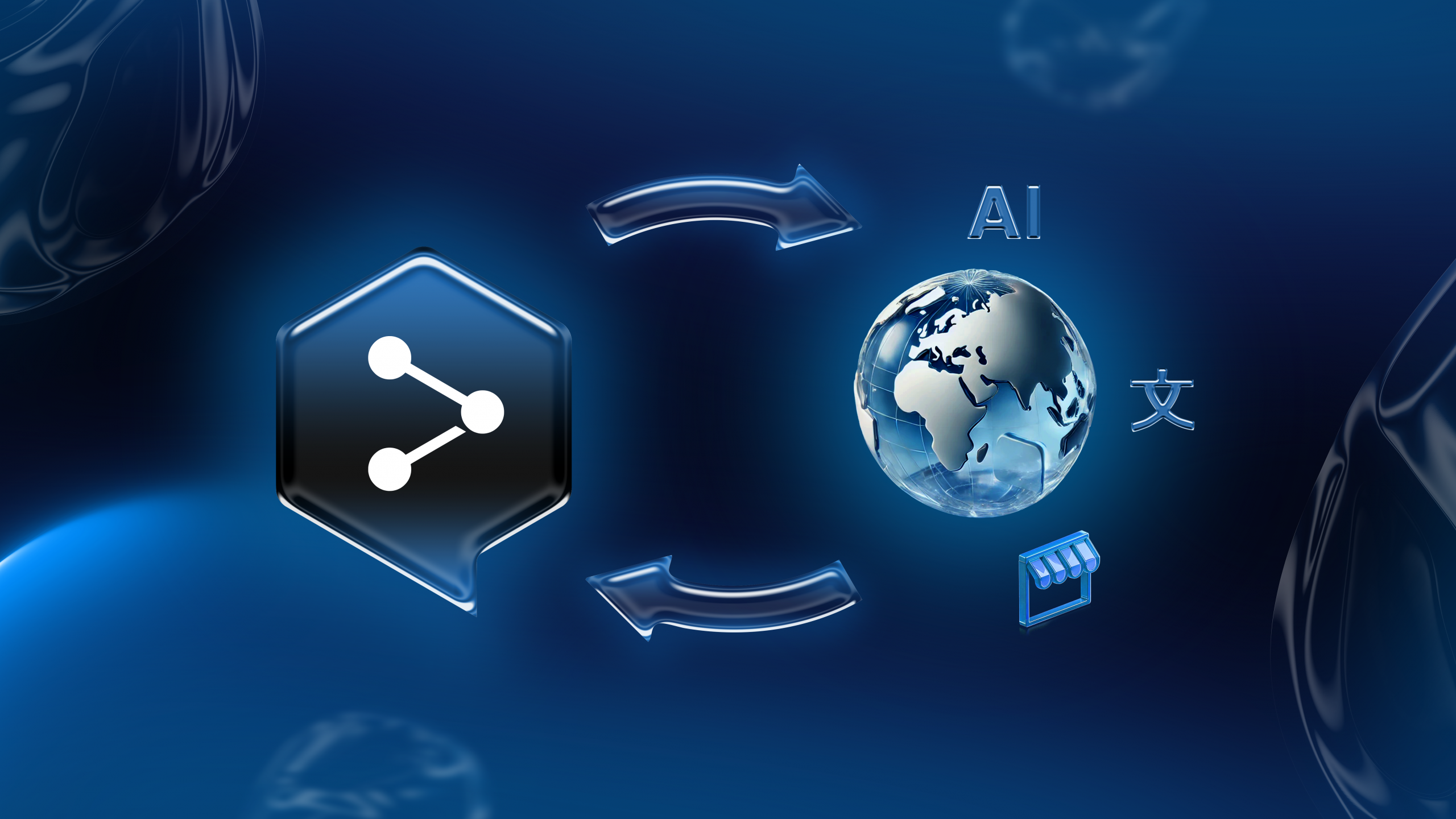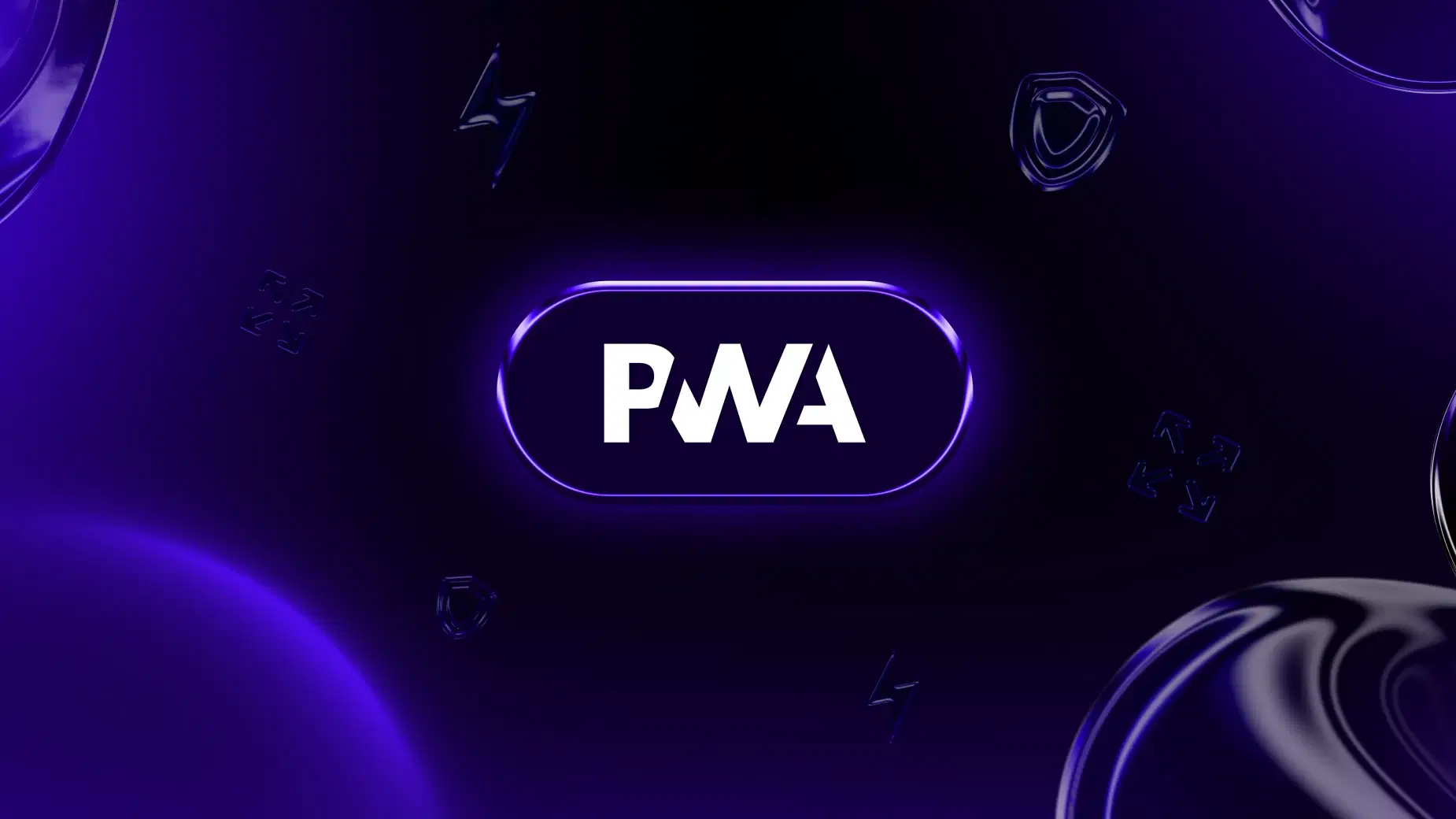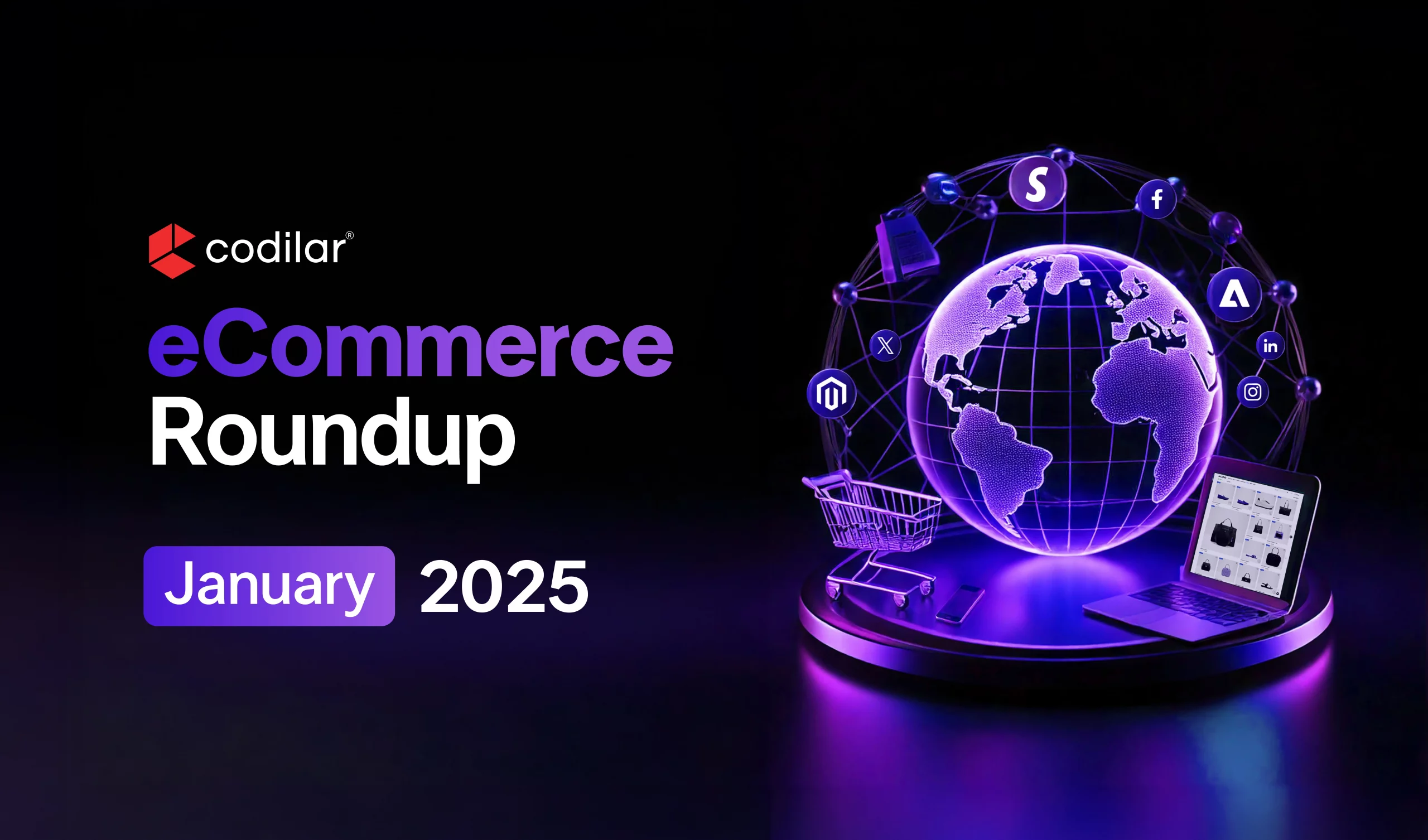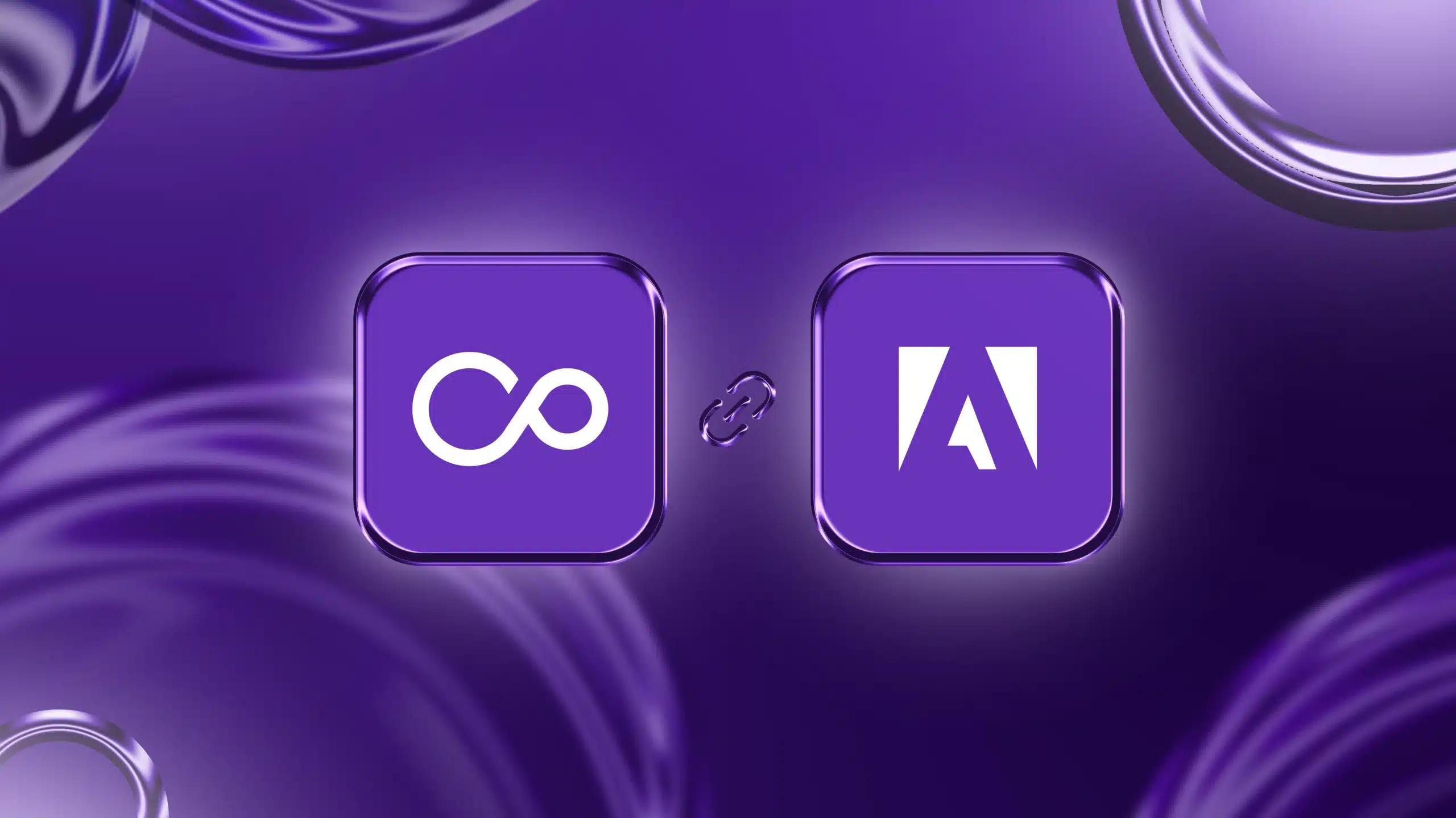Table of Contents
- Overview of AEM and Sitecore
- Understanding Adobe Experience Manager (AEM) vs Sitecore
- 1. Ease of Use
- 2. Out-of-the-box Components
- 3. Content Personalization
- 4. Technology
- 5. Digital Asset Management (DAM)
- 6. Workflow Automation
- 7. Forms
- 8. Market Share
- 9. Cloud Services
- 10. Pricing
- Closing Thoughts: Sitecore vs AEM- Which is The Better Choice?
Amidst the busy world of online shopping, you probably began your eCommerce journey wanting to make a special place for your customers. Beyond just selling stuff, you wanted to create a DXP (Digital Experience Platform), where people would eagerly return time and again to explore what you have to offer.
However, businesses often cross swords when choosing the right DXP to tackle their data management challenges and deliver an incomparable digital experience.
In this blog, we’ve brought a dynamic duo comparison between Adobe Experience Manager vs Sitecore. These platforms are hands down the two most popular competitors, creating a whirlwind of experiences within the eCommerce industry.
If you’re having trouble deciding between Sitecore vs AEM for your digital experience platform, this blog is just what you need. Dive in to explore what makes AEM distinct from Sitecore.
Overview of AEM and Sitecore
To get started, let’s first examine what AEM is.
Adobe Experience Manager (AEM)
AEM is an efficient content management (CMS) and digital asset management (DAM) system that simplifies how your website operates online. It offers a whole suite of advanced asset management and development tools, utilizing which you can transform your digital experience platform to a new level.

With this comprehensive AEM content management platform you can create aesthetically pleasing storefronts and dynamic web pages, while rolling out automated content strategies, on any devices or mobile application. Get rid of the experience management complexities and simply create, manage, and deliver targeted content across diverse touchpoints.
Furthermore, AEM is also available as Cloud Service offering cloud-native flexibility to equip your store with auto-scaling superpowers. Meaning, that with AEM you can streamline your workflow, DevOps, and productivity like never before while offering users personalized and user-friendly experiences.
Now, let’s take a look at AEM’s contender, Sitecore.

Sitecore
Sitecore Experience Platform (XP) is a powerful end-to-end digital experience platform, offering a full package of advanced web content management solutions (CMS) powered by .NET. It can assist you in strategizing and delivering top-notch experiences online.

From managing content to delivering personalized and automated marketing campaigns and experiences, Sitecore covers all the bases. How? By expertly combining customer data, website content, commerce, and experience into one platform. It’s like having a one-stop shop for everything you need to create a stylish and modern online store that perfectly fits your business needs.
In addition to its wide range of commerce and asset management tools, Sitecore CMS offers a set of martech stack with intelligent data mapping features. This helps in creating, managing, and executing campaigns while analyzing their performance in real-time. It also easily merges with any API-first platform, extending its functionalities even further with interconnected systems and other eCommerce platforms.
Understanding Adobe Experience Manager (AEM) vs Sitecore
Now, let’s categorize Adobe Experience Manager vs Sitecore on several key aspects to see who rules the other.
1. Ease of Use
AEM provides an easy-to-use admin dashboard with rule-based authoring and WYSIWYG features. It also provides an array of online tools that enhance the speed of content creation and streamline the workflow efficiently. What sets the dashboard apart from other DXPs is that these can be custom-built based on your team’s requirements. Users can manually represent each project as separate tiles by adding or editing links or details about the team.
However, users need to be mindful of specific authoring guidelines when creating or editing content or component design via the AEM platform. Meaning, it has a steep learning curve and for non-technical users using AEM may be slightly overwhelming.
Whereas, Sitecore XP presents a familiar and intuitive WYSIWYG interface, even for non-technical users, making its learning curve less steep compared to AEM. It also implements a rule-based access, simplifying how users can edit and track the content lifecycle. In addition, being a .NET powered CMS, developers proficient in any supported language can easily deploy code and navigate across sites through a single platform.
2. Out-of-the-box Components
AEM provides a curated list of pre-installed components that designers can flexibly play with to create eye-catching customer-facing web pages. This is economically advantageous and requires less development time, as it does not have to be developed from scratch, needing little to no extra code. Click here to check out AEM core components.
See how our experts at Codilar revamped Ooka’s website into a stunning and engaging online store with AEM implementation.
When compared to Adobe Experience Manager vs Sitecore offers limited out-of-the-box functionalities. Though it offers a wide array of in-built standard components, called rendering, their functionalities are limited to text, images, videos, plugins, etc. For that matter, Sitecore requires custom component development and coding.
3. Content Personalization
AEM can achieve better traction of user behavior and cross-channel analytics by integrating with other third-party systems such as CMS or CRP. It also creates real-time customer profiles, enabling teams to customize workflows and deploy tailored interactions across every channel. Such insights not only help in providing highly targeted content experiences but also can drive more traffic to your website.
In addition to AEM content management if you want to further drive your digital experience personalization journey to even greater heights you can also implement Adobe’s suite of tools, offering you a bunch of different marketing features at scale.
Sitecore XP is undoubtedly an efficient web content management solution with additional capabilities like inventory management, order tracking, and more. Its advanced tool set, when leveraged properly, can help marketing teams create waves across every touch point with personalized customer experiences. This not only contributes to enhancing customer engagement and conversion rates but can significantly uplift your team’s productivity.
Besides, Sitecore comes with composable DXP features that enable businesses with the flexibility to choose products out of Sitecore to enhance their platform capabilities.
4. Technology
AEM is an open-source platform built on Java-based architecture with Apache Sling framework. One of the standout features that makes AEM the ideal choice for fast-scaling enterprises is its architecture which supports modularity. Using the modular approach developers can independently build, customize, and deploy components, facilitating the seamless addition of new features to websites.
However, organizations planning to invest in AEM should have resource-intensive platforms with adequate infrastructure to support heavy-weight components of Java-based applications.
Whereas, Sitecore is built on the Microsoft ASP.NET framework which is currently running on version 10.3. Its robust APIs allow developers to query Sitecore items instantly using a wide variety of technologies, from .NET web forms to XSLT and MVC. For enterprises already operating within the Microsoft ecosystem and those who are familiar with .NET development, Sitecore is the ideal choice. This is because of its irreplaceable compatibility with all Microsoft products and services.
However, when it comes to integrating with non-Microsoft solutions it may incur additional licensing costs and expertise.
5. Digital Asset Management (DAM)
AEM has built-in DAM that smoothly integrates with Adobe’s web content management systems to function as a dynamic content engine. With a unified set of repositories and powerful metadata capabilities, you can streamline workflows and incorporate feature-rich media. This simplifies the retrieval and distribution of the latest assets across channels. Besides, it has strong permission controls enabling users to set usage and distribution guidelines for asset safety.
Adobe has further enhanced AEM’s DAM with extra features like
- Limited user feature to control multiple versions of an asset.
- Streamlined asset distribution amongst channel partners and external teams.
- Effortless asset conversion into sales material.
- Implementation of Smart Crop and Smart Tags features with Adobe Sensei to easily customize assets and improve searchability.
While in Sitecore, digital asset management functionality is taken care of by Sitecore Content Hub. It offers a centralized single repository seamlessly integrating with other cloud solutions and design tools, allowing easy discovery of existing assets to meet marketing requirements efficiently. This also allows streamlined version control and system exchanges
6. Workflow Automation
AEM can handle multiple workflow tasks concurrently by applying automation, wherever necessary. In general, the workflows in AEM fall into two categories: programmatic and human-driven. Programmatic workflows enable you to apply specific business rules to process content, while human-driven workflows involve notifying administrators to review and approve content before publishing it on sites.
Benefits of such automated workflows are that you can concentrate on your content quality while AEM takes care of routing of tasks to remind administrators of their deliverables.
Similarly, Sitecore makes it easy for you to set up any number of workflows with three simple stages: editing, sending for approval, and approval. Plus, it comes with a handy ‘preview publishing’ feature. This lets outside reviewers share their feedback by clicking on a special link sent to them, no need for them to log in to Sitecore.
Here are some more advantages of using Sitecore’s workflow:
- It gives you a workbox where you can easily see, review, and organize content at different stages of the workflow.
- You can lock content in the workflow to prevent multiple users from accidentally overwriting each other’s work.
- It automatically creates new versions of your content as you make edits, helping you keep track of changes over time.
- Before content gets sent for approval, Sitecore checks it for any errors or missing information.
- Following approval, Sitecore’s automated publishing feature swiftly publishes the content to your site, saving you both time and effort.
7. Forms
With AEM forms, moving your paper forms to the digital world is a piece of cake. You can personalize enrollments by easily creating user-friendly forms and monitoring their performance in real-time on any device. With its drag-and-drop functionality, you can create custom forms in minutes to fit your requirements. No matter the device, AEM allows you to publish forms to any screen size.
AEM can also auto fill forms. How? By simply using Adobe’s APIs, along with AI and machine learning intelligence, it can retrieve data from back-end systems or partially completed forms. This not only saves customers time but also keeps them engaged.
In addition, AEM simplifies authoring forms and communications. You can automate form conversion, integrate data sources, promote reusable form fragments, and create personalized communications for different channels.
Similarly, Sitecore forms provide you with great flexibility to create customized web forms from a range of templates or according to your specific needs. However, it lacks the capability to efficiently convert your old paper forms into digital ones.
8. Market Share
According to reports, there are approximately 131,582 AEM sites, with nearly 39,961 currently live. These figures speak volumes about AEM site’s soaring popularity and its remarkable capabilities to handle medium to heavy traffic loads. It’s no wonder AEM content management solution has secured the top fourth spot amongst the preferred CMS solutions within the world’s top 10K high-traffic enterprises.
Here’s how Ooka transformed its online presence by adopting AEM and Adobe Experience Cloud solutions.
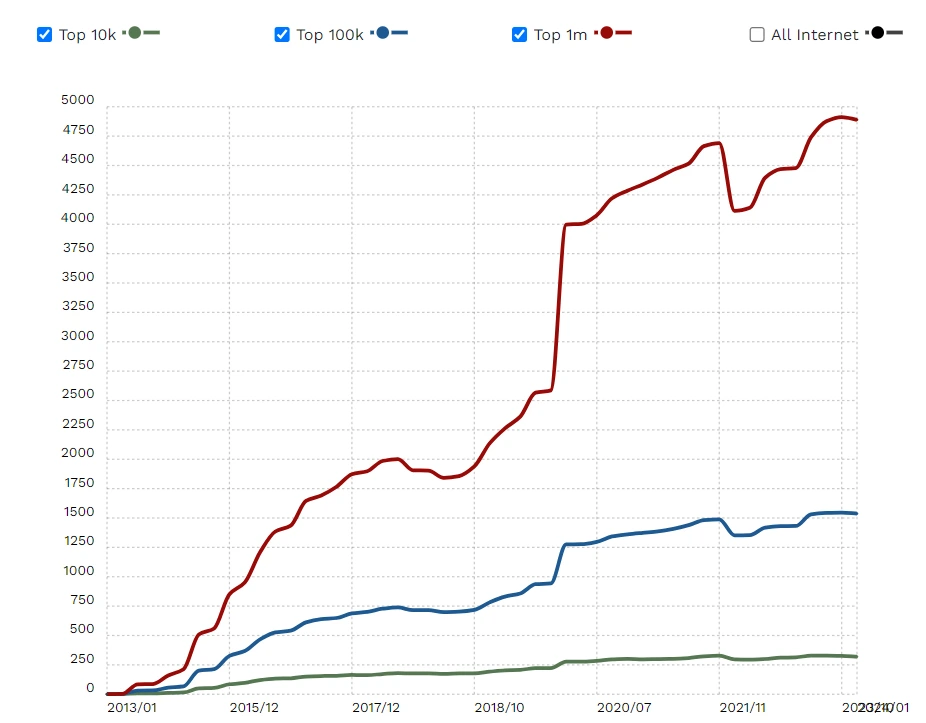
In contrast to AEM, Sitecore’s adoption rate among high-traffic websites is relatively lower, placing it at the 20th position among popular DXPs. However, among the 10,583 live websites leveraging Sitecore, notable platforms such as Mayoclinic, GoDaddy, Ballotpedia, and Netlify stand out for their significant enhancements in user experience.
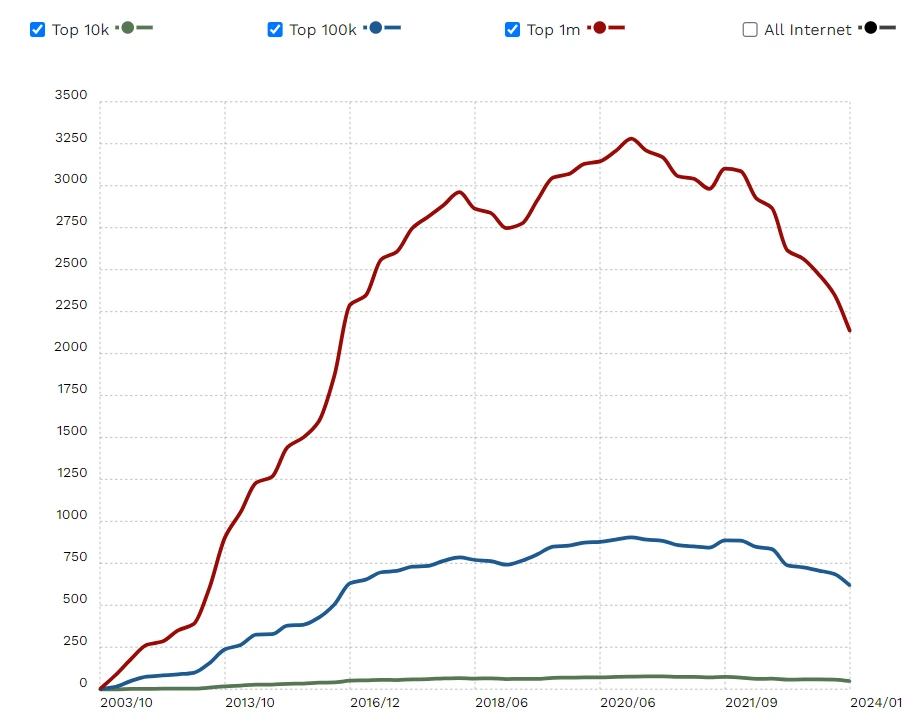
9. Cloud Services
AEM’s cloud services take care of product updates or version upgrades on its own, letting your business stay current with dynamic scalability. Now you can concentrate on enhancing customer experiences with innovations rather than deploying development teams to spend hours on upgrading and fixing issues.
Meanwhile, Sitecore provides two flexible options with managed cloud service (Platform DXP) and SaaS cloud services (SaaS DXP). In the former, your business can select a host cloud infrastructure like Microsoft Azure and deploy Sitecore CMS without overburdening your on-premise setup with disparate integrations. Whereas, in SaaS DXP, Sitecore hosts the infrastructure and efficiently manages all its operations.
10. Pricing
AEM provides a subscription-based licensing model and is slightly costlier when compared to Sitecore CMS. However, Adobe discounts are available for businesses that commit to long-term use, which can help mitigate costs. As your business scales, you may need additional products in your tech stack and may even have to custom develop and design features to enhance your platform capabilities, which can incur additional costs.
Whereas, Sitecore comes with a competitive perpetual licensing model, wherein, the tool is all yours for a lifetime once you invest. It’s ideal for enterprises that have stable traffic patterns and who do not want to explore advanced features with new releases.
Here’s a comparison table summarizing the key points discussed in the blog post:
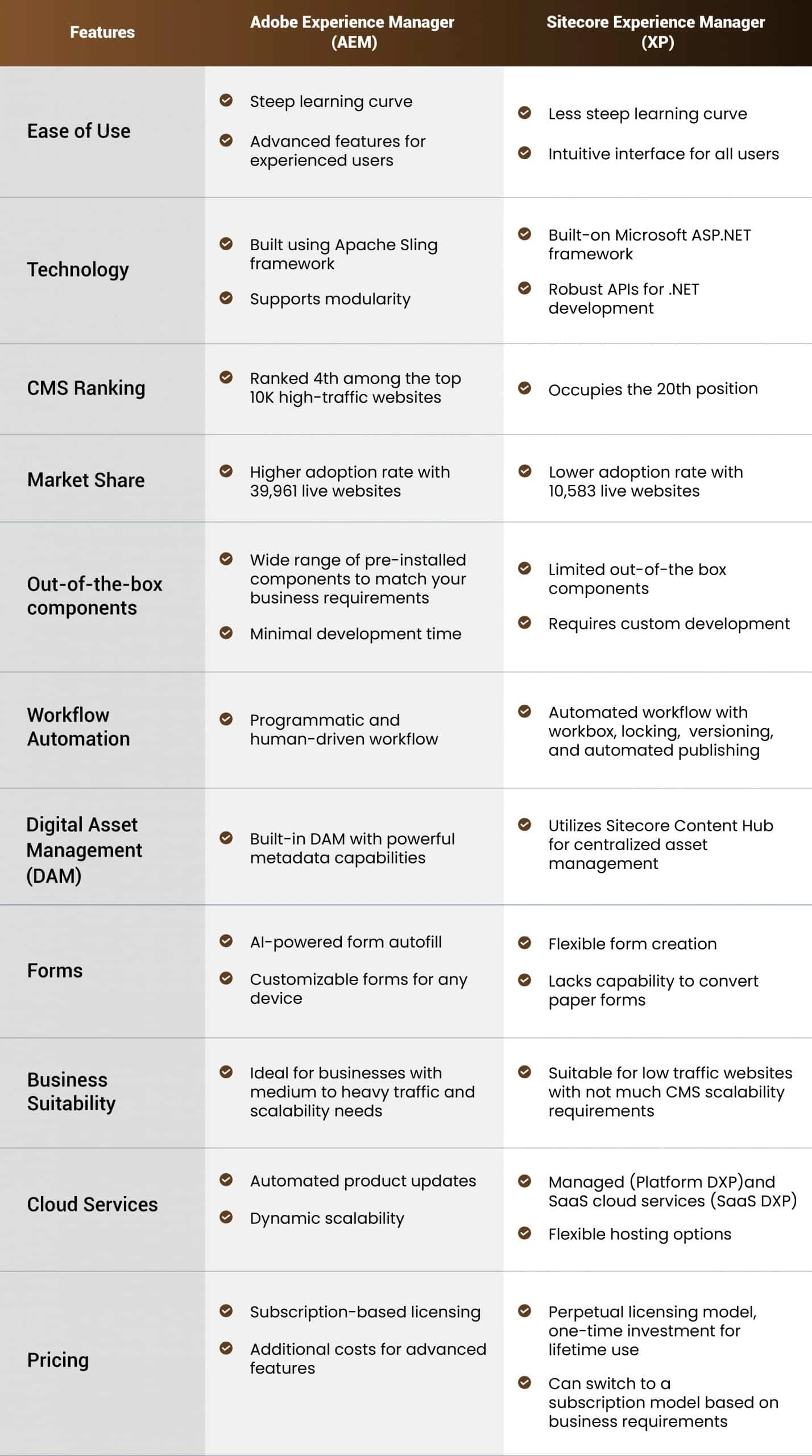
Closing Thoughts: AEM or Sitecore – Which is The Better Choice?
In summary, while Sitecore and AEM share many functional similarities, each possesses distinctive features that set them apart within the landscape of Digital Experience Platforms (DXPs).
Sitecore offers a robust CMS solution suitable for enterprises aiming for gradual scalability within their existing capabilities. On the other hand, AEM provides faster scalability coupled with a familiar framework and out-of-the-box components, ideal for businesses seeking expansive growth opportunities and aesthetically captivating websites.
While we’ve conducted a comprehensive comparison between Adobe Experience Manager vs Sitecore, determining the best platform for your business ultimately depends on your specific needs, available resources, and scalability objectives.
If you need help making the right choice for revamping your DXP, our experts are here to help. We have a legacy of creating exceptional digital experiences for popular brands through our innovative solutions and tech-backed AEM development services. Contact us today and let our experts do the rest.



